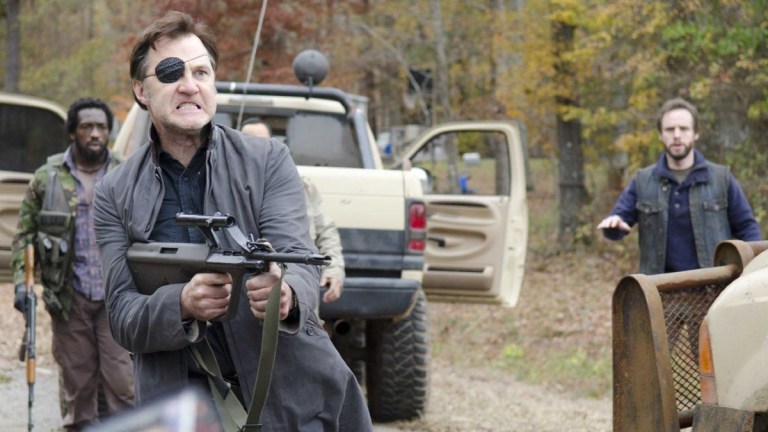Every Walking Dead Villain Eventually Becomes The Governor
Philip Blake a.k.a. The Governor provided the blueprint for every Walking Dead villain after him.

This article contains spoilers for The Walking Dead season 11 episode 19.
Over a decade ago, The Walking Dead started out as a series depicting the horrors of a post-apocalyptic world in which re-animed humans have come back after death to eat the living. This is all very typical of the zombie genre, but fans were quickly treated to what made the show different, and actually quite revolutionary compared to its rivals. After the initial threat of a walker (the most common name for the zombies) or two has been snuffed out, humans have to worry about recreating a world that is habitable for the survivors. This quickly leads to the most realistic epiphany in the series: people are the biggest threat to each other, end of the world or not, because humans are often inherently selfish and weak.
There were a few characters in the first two seasons who epitomized this idea, chief among them Shane Walsh (Jon Bernthal). Shane was a traitor to his best friend Rick Grimes (Andrew Lincoln), but he was hardly ever a danger to more people than the dozen or so in the original camp (let’s pour one out for Otis [Pruitt Taylor Vince], though). It’s when the show introduced a man who was aptly dubbed the Governor (David Morrissey) that we saw how devastating a great villain could be in this universe.
Creating a Community
The Walking Dead has many main themes, but perhaps the most overarching one across all 11 seasons is the drive to build a community of survivors. When humans bond together instead of working against each other, a plethora of possibilities open up. Philip Blake a.k.a. The Governor played on the naivete of people looking for a slimmer of hope during the end times. When we first learn about his presence in season 3, he brings Michonne (Danai Guriria) and Andrea (Laurie Holden) into his sanctuary, Woodbury. The town is secluded and safe, barricaded from the perils of the walkers and other external enemies. What we start to quickly realize is that the main threat to the community is the leadership of the Governor.
This is a man who is clearly not in the right state of mind to lead anybody, much less a group of vulnerable people looking to rebuild the world. He has many secrets that are revealed like dominoes toppling on top of each other, such as the fact that he keeps his zombified daughter in his home and cuts off the heads of his adversaries, keeping them in jars like the freakiest of serial killers.
When you take into account the Governor’s twisted sense of morality and his fetish for preying on the remains of the planet, both literally and figuratively, the man whose real name is Philip Blake is more dead inside than any walking corpse could ever attempt to be. His charisma and sharp tongue in front of an audience eerily allude to some of the real world’s most despicable dictators and presidents. When you see how easily Americans have been manipulated by their politicians historically, it’s no wonder the residents of Woodbury were so compliant to the Governor’s two-faced fabrication.
The idea of a community is something the Governor certainly had the right idea about, because various other forms of permanent housing have been constructed in the ensuing seasons of the show, from the Hilltop to Alexandria and now the super-community of The Commonwealth (also led by a governor). The concept of said community being a Trojan Horse was also quickly mimicked from Woodbury, as places like Terminus and Grady Memorial Hospital in seasons four and five started out as asylums, only to be painted in their proper shade of black quickly henceforth.
Psychos Galore!
The Governor helped set the precedent for many of the mentally-depraved motives of the bad guys in later seasons of The Walking Dead. Discussing the psychological ills of TV characters is always a bit of a precarious endeavor, as all of us couch-therapists throw around terms we don’t fully understand. Is he a sociopath? Is he a psychopath? Does he have antisocial personality disorder? The discourse around diagnosing these people arguably started during the meta-analysis of Tony Soprano (James Gandolfini) during his sessions with Dr. Jennifer Melfi (Lorraine Bracco) in the critically acclaimed forebear to modern dramas, The Sopranos. Ever since then TV writers have gotten more creative and more daring in morphing different types of evil together to resemble some of history’s worst monsters.
The main antagonists at the beginning of the fifth season, Gareth (Andrew J. West) and his cannibals, continued to feed into the narrative that all of the villains in the show were going to have a major screw loose in some way or another. This legacy continued with Alpha (Samantha Morton) and the Whisperers, who infamously cloak themselves in the flesh of the dead. The Governor almost single-handedly showed that many of the future villains in the series were going to flex their evil by having a disgusting fascination with the human body, whether that means eating it, wearing it, or keeping it as a souvenir. No PhD is required to diagnose these nutsos.
Creating the Shock Death
Perhaps no scene in The Walking Dead is as famous (or infamous) as the concluding one that connects the end of the sixth season finale and the beginning of the seventh season premiere. When Negan (Jeffrey Dean Morgan) finally arrives on the screen, he commences his introduction by obliterating the heads of beloved heroes Glenn Rhee (Steven Yeun) and Abraham Ford (Michael Cudlitz). It’s a jarring set of events that traumatized audiences forever, but it may have never happened if the Governor hadn’t already performed an even more egregious act in one of the most mesmerizing episodes, the fourth mid-season finale “Too Far Gone”.
Hershel Greene (Scott Wilson) wasn’t just the moral GPS of Rick’s group of survivors, he was a gargantuan grandfather figure to the audiences watching at home. Herschel’s core set of values, his ability to stay steadfast in his convictions, and his uncanny desire to hang onto non-existent hope for the future was what guided everyone in the appropriate direction for multiple seasons of the series. When the Governor decapitated Hershel, it single-handedly created a measuring stick for what a shock death in The Walking Dead was going to have to live up to. The Governor became a symbol of human demise, the tangible realization that anything pure would be snuffed out from that point forward.
For all of these reasons, the Governor was the best and worst thing that ever happened to the show. He carved out a standard of depravity that was easy to impersonate, but impossible to duplicate. Even when The Walking Dead opts to try something different by introducing the banal bureaucratic evil of The Commonwealth, it defaults right back to gory spectacle. In season 11 episode 19, Pamela Milton (Laila Robins) becomes literally the second “governor” to keep their undead child around post-mortem.
The Governor’s legacy still lingers as The Walking Dead nears its well-overdue climax in just a few episodes, and his character arc makes the first few seasons of the series incredibly rewatchable.
